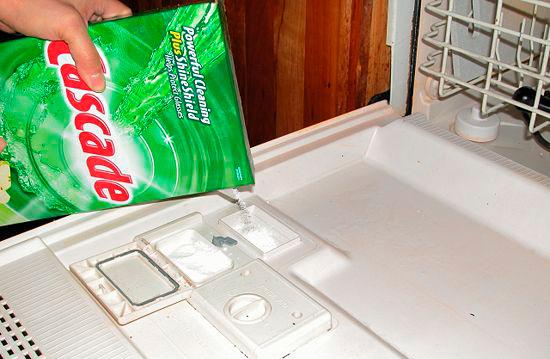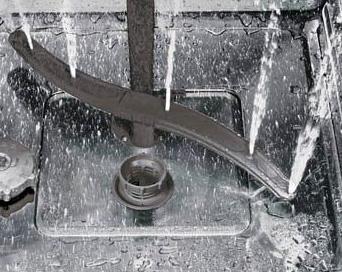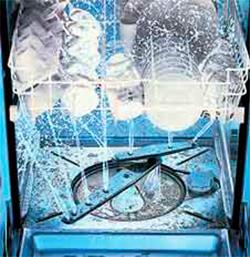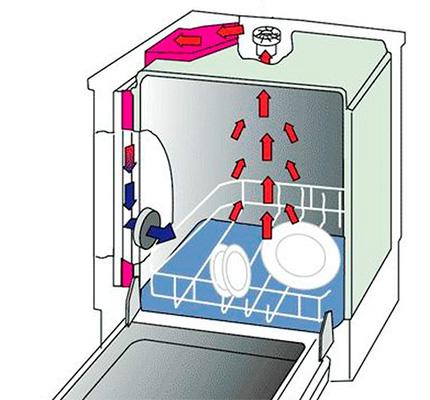Dishwashers are not common kitchen appliances. And many people simply do not know how these devices work. In order for you to understand how a dishwasher works, we have created this detailed overview. In it you will find information about all stages of washing and about the processes taking place at this time. After reading the review, you will understand how dishwashers work and what determines the quality of washing.
In total, we can consider three main stages of washing dishes:
- Main sink;
- pre-rinse;
- final rinse;
- Drying.
After the completion of the next cycle, the dishwasher gives one or another signal. The principle of operation of this technique is simple - read our review to the end, and see for yourself.
Dishwasher, device and the principle of operation of which we analyze in this article, consists of the following elements:
- Engine (aka circulation pump) - provides water injection into the rocker arms, driving it in a circle;
- Rocker arms - through them, water is thrown into the working chamber of the dishwasher (cold, hot, with powder or rinse aid);
- Filter - it is designed to retain solid particles of contaminants (clean water must flow into the engine of the apparatus);
- Drain pump - dirty water and waste from the filter are removed through it;
- Heating element - flow or classic. Provides heating of water to a predetermined temperature (the maximum limit rarely exceeds +70 degrees);
- Baskets for dishes - we lay kitchen utensils in them. It is under these baskets that the rotating rocker arms are located.
Also, some models of dishwashers have sensors that evaluate the amount of dishes, the degree of contamination, and many other parameters. The principle of operation of such devices is more complicated, but the presence of automatic programs allows you to count on the impeccable cleanliness of cups / spoons.
Before starting the dishwasher

How the washing machine works and what its principle of operation is known to every person. It has a drum in which laundry is laid. During the washing process, the laundry rubs against each other, as well as against the walls of the drum, as a result of which the dirt gradually disappears. This whole process is helped by effective washing powders, consisting of many components. However, it is not at all necessary to describe the principle of operation in words - it is enough to look inside the drum to guess about it yourself.
Dishwashers are arranged differently:
- There is no special drum here;
- The dishes in the dishwasher remain motionless;
- Dishes do not rub against each other;
- There are no elements in the dishwasher that come into contact with the dishes mechanically.
The principle of operation of the dishwasher is built in a completely different way - in fact, washing here is carried out by jets of water escaping at high speed from rotating rocker arms. To achieve results, special detergents are added to the water, effectively removing any dirt from the surface of kitchen utensils.
Next, we will consider the process in stages. Before starting the dishwasher, we need to load it with salt, powder and rinse aid. Salt is loaded into a special container, access to which is in the working chamber. It fits about a kilogram here. As for the powder and rinse aid, they are poured / poured into special dispensers outside the dishwasher (much like it is done in washing machines).
After pressing the start button, the dishwasher starts the main washing process. In some cases, this stage is preceded by pre-soaking - the principle of soaking is that the dishes are poured with water. Due to this, the contaminants begin to “turn sour”, and in the future they are easily removed using hot water with a detergent dissolved in it.
Dishwashing process
Considering the principle of operation of the dishwasher, we have come to the most important stage - this is the main wash. Water begins to enter the machine, which is heated to a predetermined temperature. After that, detergent is added here. Please note that instantaneous water heaters are installed in some dishwashers - they significantly speed up the washing process, since the water heats up to the desired temperature instantly, and not gradually.
Main wash

After the water is heated and detergent is added to it, the main stage begins - washing the dishes. Sprinklers/rockers come into action. They have tiny holes through which jets of water escape at high speed. Hitting the dishes at different angles, they wash off the dirt, after which the dirty water falls to the bottom of the working chamber on its own..
The principle of operation of the main cycle is the continuous "shelling" of kitchen utensils with tight jets of water with detergent. Due to the high speed and the action of surfactants, dirt from the surface of plates, cups and spoons is gradually washed down. Water goes through the following stages:
- Falls to the bottom of the working chamber and enters the filter;
- It is filtered and sent back to the circulation pump;
- It is re-directed through the rocker to the dishes.
Thanks to this principle of operation, a household dishwasher saves water - from 8 to 14 liters are consumed per cycle.
The main wash in the dishwasher can last quite a long time - it all depends on the selected program or the degree of soiling of the dishes. In the latter case, the dishwasher itself can control the purity of the water by independently adjusting the duration of the cycle. In non-automatic programs, the duration is set at a static level.
Pre-rinse

Talking about how the dishwasher works, we came to one of the intermediate stages - it performs a pre-rinse. By this time, all the dirt has already been washed off, but they could remain on the surface of the dishes. There is also a lot of detergent in here that needs to be removed.To do this, the dishwasher collects cold water and starts rinsing, spraying jets of water. As in the previous stage, the waste water is collected at the bottom and flows back into the pump.
If you turn off the dishwasher after completing the cold water rinse, you will have almost clean dishes at your disposal. If you wipe it with a towel and send it to dry on a shelf, literally in half an hour or an hour you can use it again. But in our case, washing continues further - the final rinse is next in line.
The last rinse is already done with hot water, which contains rinse aid.. This combination allows you to achieve impeccable cleanliness of dishes. In addition, the rinse aid gives porcelain, glass and metal hydrophobic properties - water drops themselves roll down, unable to cling to the materials from which plates, cups, bowls, pots, etc. are made.
Even a child can understand how the dishwasher works at the rinsing stage. Hot water simply splashes on the surface of the dishes, after which it flows down. After the stage is completed, it is removed outside the dishwasher. The last step left in line is drying.
Drying dishes

There are two types of drying:
- Condensation - in fact, dishes dry by themselves, due to their internal temperature. The last rinse raises its temperature, which causes more intensive evaporation.The use of rinse aid plays a special role here - without it, the surface of the cups / plates would remain unnecessarily wet. And since the surface tension is greatly weakened, excess water drops flow down on their own, helping condensation drying;
- Turbo dryer - it differs in that it dries with hot air. In principle, it can do without rinse aid, but it is necessary for a more thorough removal of residual dirt. The principle of operation of a turbo dryer is to blow hot air with a small fan. Heating is carried out using an air heating element.
Condensation drying works for a very long time - its principle of operation affects. At this time, the dishwasher does not show any signs of life, nothing hums in it and nothing rotates. Power consumption is minimal, less than one watt.
Turbo drying implies an increase in the consumption of electrical energy, since there is a heating element here - its principle of operation involves the injection of hot air. But in general, the consumption is small, the device will not consume kilowatts of energy. But the dishes at the exit will be perfectly dry - if condensation drying still allows misfires, then here they are extremely rare.
End of the program

We already know how a dishwasher works:
- Carries out the main wash by spraying water with detergent chemistry;
- Rinses twice to remove food and detergent residues;
- Drying in one way or another.
This principle of operation is incorporated in all, without exception, dishwashers. At the last stage, the technique notifies its owners about the end of the cycle - this is done with an audible indication, a light beam on the floor or with a digital indicator. The most interesting thing is that there is no sound signal in about half of the cars - usually in such models an alternative indication is provided.
Now you know everything about the principle of operation of modern household dishwashers in order to make a decision - to buy or not to buy this equipment home. Dishwashers these days give great results, so you can put your doubts aside – your kitchen utensils, wine glasses, crystal, pans and pots will sparkle. The main thing is that the pollution should not be as thick as a finger - you can’t always cope with such dirt and hands.
